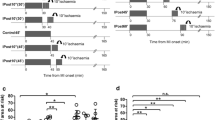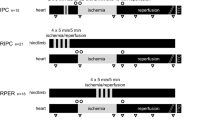Abstract
The delayed phase (‘second window’) of protection induced by ischemic preconditioning in rabbit heart is observed as enhanced resilience to infarction 24 hours after repetitive brief cycles of ischemia. Here we provide a fuller physiological characterisation of this phenomenon in the open-chest rabbit model, examining temporal characteristics and dose-dependency of this adaptation. For examination of the timecourse of delayed protection, rabbits were pretreated with four 5 minute coronary artery occlusions (PC) or sham operation (SHAM). Twenty four, 48, 72 or 96 hours later, infarct size after 30 min coronary occlusion and 120 minutes reperfusion was assessed with TTC staining and expressed as a percentage of myocardial risk volume (I/R). I/R was reduced at 24 hours (SHAM 48.1±3.9% v PC31.4±3.0%, P<0.01), 48 hours (SHAM 41.9±3.0% v PC 19.6±6.3%, P<0.01), and 72 hours (SHAM 39.8±3.4% v PC 17.2±2.5%, P<0.01). No protection was observed 96 hours after preconditioning (SHAM 35.0±4.8% v PC 36.9±3.8%). In a further study, animals were pretreated with one, two or four 5 minute coronary occlusions (1×5 PC, 2×5 PC, 4×5 PC) and subjected to the infarction protocol 48 hours later. I/R was 44.5±4.3% in SHAM, 24.8±4.4% in 1×5 PC (P<0.01), 27.4±2.9% in 2×5 PC (P<0.05) and 24.4±4.8 in 4×5 PC (P<0.01). Delayed protection in this rabbit model is prolonged, extending between 24 and 72 hours after the preconditioning stimulus. The threshold for eliciting the second window of protection in this model is as low as one 5 minute coronary occlusion.
Similar content being viewed by others
References
Baxter GF, Goma FM, Yellon DM (1995) Involvement of protein kinase C in the delayed cytoprotection following sublethal ischaemia in rabbit myocardium. Br J Pharmacol 115: 222–224
Baxter GF, Marber MS, Patel VC, Yellon DM (1994) Adenoine receptor involvement in a delayed phase of myocardial protection 24 hours after ischemic preconditioning. Circulation 90: 2993–3000
Cohen MV, Yang X-M, Downey JM (1994) Conscious rabbits become tolerant to multiple episodes of ischemic preconditioning. Circ Res 74: 998–1004
Heads RJ, Baxter GF, Latchman DS, Yellon DM (1995) Delayed protection in rabbit heart following ischaemic preconditioning is associated with modulation of HSP27 and superoxide dismutase at 24 hours. J Mol Cell Cardiol 27: A163 (abstract)
Heads RJ, Baxter GF, Yellon DM (1996) Changes in the activity of SOD and subcellular distribution of HSP70 and HSP27 during delayed ischaemic preconditioning in rabbit heart. J Mol Cell Cardiol 28: A31 (abstract)
Hoshida S, Kuzuya T, Fuji H, Yamashita N, Oe H, Hori M, Suzuki K, Taniguchi N, Tada M (1993) Sublethal ischemia alters myocardial antioxidant activity in canine heart. Am J Physiol 264: H33-H39
Hutter MM, Sievers RE, Barbosa V, Wolfe CL (1994) Heat-shock protein induction in rat hearts. A direct correlation between the amount of heat-shock protein induced and the degree of myocardial protection. Circulation 89: 355–360
Imagawa J, Baxter GF, Yellon DM (1997) Genistein, a tyrosine kinase inhibitor, blocks the second window of protection 48 hours after ischaemic preconditioning. Br J Pharmacol; in press
Kaeffer N, Richard V, Thuillez C (1996) Delayed beneficial effects of preconditioning against reperfusion-induced coronary endothelial dysfunction. Evidence for a ‘second window’ of endothelial protection. Eur Heart J 17 (abstract suppl): 268 (abstract)
Kaszala K, Vegh A, Parratt JR, Papp JG (1996) Time course of pacing-induced preconditioning in dogs. J Mol Cell Cardiol 28: 2085–2095
Kloner RA, Przyklenk K (1994) Is preconditioning relevant to clinical medicine? In: Przyklenk K, Kloner RA, Yellon DM (eds), “Ischemic Preconditioning: The Concept of Endogenous Cardioprotection”, Kluwer Academic Publishers: Boston
Kuzuya T, Hoshida S, Yamashita N, Fuji H, Oe H, Hori M Kamada T, Tada M (1993) Delayed effects of sublethal ischemia on the acquisition of tolerance to ischemia. Circ Res 72: 1293–1299
Marber MS, Latchman DS, Walker JM, Yellon DM (1993) Cardiac stress protein elevation 24 hours following brief ischemia or heat stress is associated with resistance to myocardial infarction. Circulation 88: 1264–1272
Maxwell MP, Hearse DJ, Yellon DM (1987) Species variation in the coronary collateral circulation during regional myocardial ischaemia: a critical determinant of the rate of evolution and extent of myocardial infarction. Cardiolvasc Res 21: 737–746
Miura T, Adachi T, Ogawa T, Iwamoto T, Tsuchida A, Iimura O (1991) Does myocardial stunning contribute to infarct size limitation by ischemic preconditioning? Circulation 84: 2502–2512
Sun J-Z, Tang X-L, Knowlton AA, Park S-W, Qiu Y, Bolli R (1995) Late preconditioning against myocardial stunning: an endogenous protective mechanism that confers resistance to post-ischemic dysfunction 24 h after brief ischemia in conscious pigs. J Clin Invest 95: 388–403
Tang X-L, Qiu Y, Sun J-Z, Park S-W, Sun J-Z, Kalya A, Bolli R (1996) Time-course of late preconditioning against myocardial stunning in conscious pigs. Circ Res 79: 424–434
Vegh A, Papp JG, Parratt JR (1994) Prevention by dexamthasone of the marked antiarrhythmic effects of preconditioning induced 20 h after rapid cardiac pacing. Br J Pharmacol 113: 1081–1082
Yamshita N, Kuzuya T, Hoshida S, Nishida M, Igarishi J, Hori M, Kamada T, Tada M (1995) A ‘second window of protection’ occurs 24 hours after ischemic preconditioning in rat heart. J Mol Cell Cardiol 27: A517 (abstract)
Yamashita N, Nishida M, Hoshida S, Kuzuya T, Hori M, Taniguchi N, Kamada T, Tada M (1994) Induction of manganese superoxide disnutase in rat cardiac myocytes increases tolerance to hypoxia 24 hours after preconditioning. J Clin Invest 94: 2193–2199
Yang X-M, Baxter GF, Heads RJ, Yellon DM, Downey JM, Cohen MV (1996) Infarct limitation in the second window of protection in a conscious rabbit model. Cardiovasc Res 31: 777–780
Yellon DM, Baxter GF (1995) A ‘second window of protection’ or delayed preconditioning phenomenon: future horizons for myocardial protection? J Mol Cell Cardiol 27: 1023–1034
Yellon DM, Baxter GF, Marber MS (1996) Angina reassessed: pain or protector? Lancet 347: 1159–1162
Ytrehus K, Liu Y, Tsuchida A, Miura T, Liu GS, Yang X-M, Herbert D, Cohen MV, Downey JM (1994) Rat and rabbit heart infarction: effects of anesthesia, perfusate, risk zone, and method of infarct sizing. Am J Physiol 267: H2383-H2390
Author information
Authors and Affiliations
Rights and permissions
About this article
Cite this article
Baxter, G.F., Goma, F.M. & Yellon, D.M. Characterisation of the infarct-limiting effect of delayed preconditioning: timecourse and dose-dependency studies in rabbit myocardium. Basic Res Cardiol 92, 159–167 (1997). https://doi.org/10.1007/BF00788633
Received:
Revised:
Accepted:
Issue Date:
DOI: https://doi.org/10.1007/BF00788633




